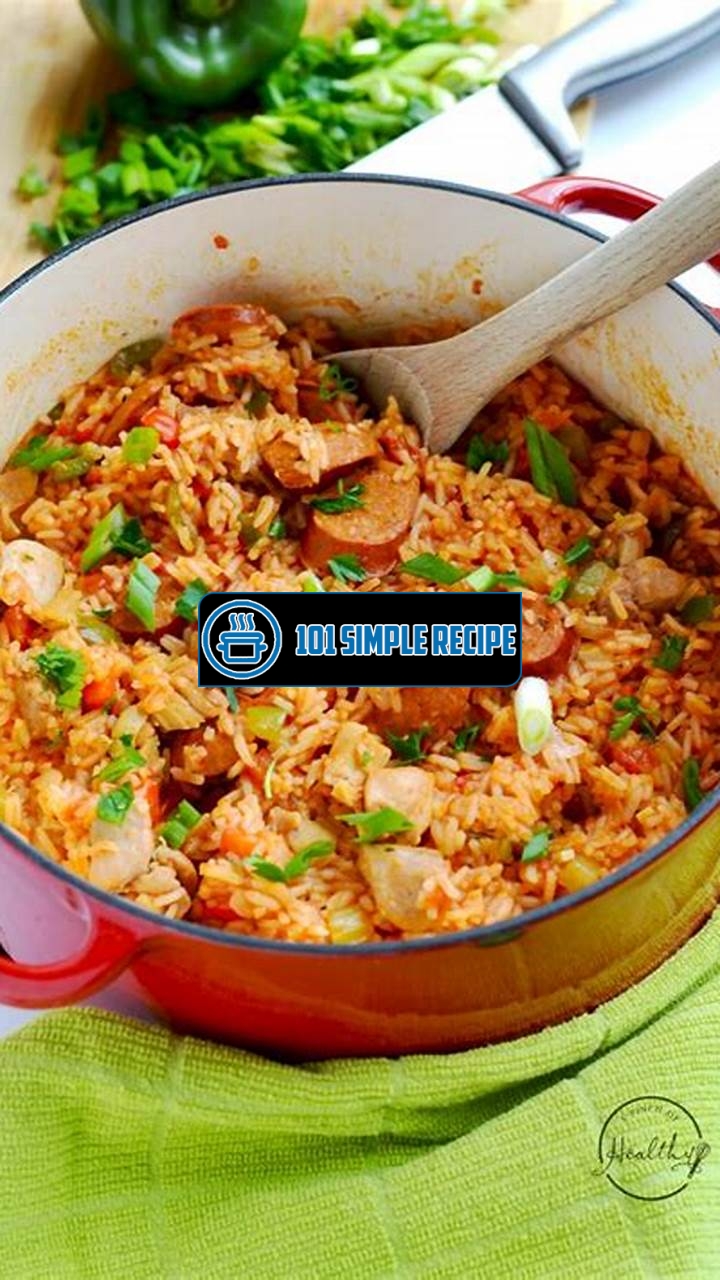Are you ready to spice up your dinner routine with a mouthwatering meal that is packed with flavor? Look no further than this delicious jambalaya recipe with chicken and sausage. ️ Jambalaya, a classic Louisiana dish, combines the bold flavors of Creole and Cajun cuisines to create a dish that is both hearty and satisfying. This recipe features tender chicken, savory sausage, and a medley of aromatic vegetables and spices, all simmered together to create a symphony of flavors. Whether you are planning a special dinner for friends or simply want to enjoy a tasty meal at home, this jambalaya recipe is sure to impress. ️✨

Understanding Jambalaya
Jambalaya is a delicious and popular Louisiana Creole dish that is known for its bold and flavorful taste. It is a hearty and satisfying meal that combines elements from French, Spanish, and West African cuisines. The dish is typically made with a combination of meat, vegetables, and rice, creating a one-pot wonder that is loved by many.
️ What is Jambalaya?
Jambalaya is a savory rice dish that originated in Louisiana, USA. It is often compared to Spanish paella or jollof rice from West Africa, as it shares similarities in its cooking method and ingredients. However, jambalaya has its own unique flavors and character that sets it apart.
The History of Jambalaya
The history of jambalaya can be traced back to the diverse cultural influences in Louisiana. The dish is believed to have originated in the late 18th century, when French and Spanish settlers arrived in the region. These settlers brought with them culinary traditions and ingredients that would eventually become the building blocks of jambalaya.
Over time, jambalaya evolved to incorporate local ingredients and techniques from West African and Native American cuisines. It became a popular dish among Louisiana Creole communities, who would often cook large batches to feed a crowd during festive gatherings and social events.
Key Ingredients in Jambalaya
Jambalaya typically includes a variety of ingredients that contribute to its unique flavor profile. The key ingredients often include:
- Meats: Chicken and sausage are the most commonly used meats in jambalaya. The combination of these proteins adds a rich and meaty taste to the dish. The chicken is usually boneless and skinless, while the sausage can be any variety, such as Andouille or smoked sausage.
- Vegetables: Onions, bell peppers, and celery are known as the “holy trinity” of Creole cooking. These aromatic vegetables provide a savory base for the jambalaya and add depth of flavor. Other vegetables, such as tomatoes and garlic, may also be included.
- Rice: Long-grain white rice is the traditional choice for jambalaya. It absorbs the flavors of the other ingredients and becomes infused with the delicious spices and seasonings.
- Spices and Seasonings: Jambalaya gets its distinctive taste from a blend of spices and seasonings. Commonly used spices include paprika, cayenne pepper, thyme, oregano, and bay leaves. These spices add heat and depth of flavor to the dish.
Note: Jambalaya is a versatile dish that can be customized to suit individual preferences. Some variations may include additional ingredients such as shrimp, crab, or ham. The heat level can also be adjusted by adding more or less cayenne pepper.
In conclusion, jambalaya is a quintessential Louisiana Creole dish that showcases the rich culinary history and cultural diversity of the region. Its origins can be traced back to early settlers and the blending of different culinary traditions. By combining a variety of meats, vegetables, and spices, jambalaya creates a harmonious and satisfying meal that continues to be enjoyed by many.
The Perfect Jambalaya Recipe
Discover a tried and true recipe for jambalaya that combines chicken and sausage for a flavorful dish. Jambalaya is a classic Cajun dish that originated in Louisiana. It is a one-pot dish that is packed with complex flavors and a delightful combination of textures.
Preparation and Cooking Techniques
Preparing and cooking jambalaya requires some basic techniques to ensure that the flavors meld together perfectly. Here are some important tips to keep in mind:
- Sauté the meats: Start by sautéing the chicken and sausage in a large pot or skillet until they are browned and cooked through. This step helps to develop the rich flavors of the meats.
- Sauté the Holy Trinity: The Holy Trinity is a combination of onions, bell peppers, and celery. Sautéing them before adding other ingredients adds depth to the dish.
- Add the rice and spices: Once the meats and Holy Trinity are cooked, add rice, tomatoes, broth, and a blend of spices such as paprika, thyme, oregano, and cayenne pepper. These spices give jambalaya its signature Cajun flavors.
- Simmer: Cover the pot and let the jambalaya simmer over low heat until the rice is cooked and has absorbed most of the liquid. This allows the flavors to meld together and gives the dish a rich, hearty texture.
- Garnish and serve: Once the jambalaya is cooked, garnish it with fresh parsley and green onions for a pop of color and added freshness. Serve it hot and enjoy!
Tips for Choosing the Best Ingredients
Choosing the best ingredients is crucial to ensure the success of your jambalaya recipe. Here are some tips to help you select the right ingredients:
- Chicken: Use boneless, skinless chicken thighs for the best texture and flavor. They are moist and tender when cooked and pair well with the sausage.
- Sausage: Opt for smoked sausage, such as andouille or kielbasa, to add a smoky and savory flavor to the dish.
- Rice: Use long-grain white rice for jambalaya. It holds up well during cooking and absorbs flavors beautifully.
- Tomatoes: Choose canned diced tomatoes for convenience. They add a rich, tangy flavor to the dish.
- Broth: Use chicken broth to enhance the savory flavors of the jambalaya. You can also use vegetable broth for a vegetarian version.
- Spices: Make sure your spices are fresh for the best flavor. Check the expiration dates and store them in a cool, dry place to maintain their potency.
Enhancing the Flavor Profile
To take your jambalaya to the next level, consider these additional flavor enhancements:
- Smoked paprika: Add a touch of smoky complexity by using smoked paprika in your spice blend.
- Hot sauce: For heat lovers, serve the jambalaya with a side of hot sauce or drizzle some directly over the dish before serving.
- Bay leaves: Toss in a couple of bay leaves while simmering. They add subtle earthy notes to the jambalaya.
- Seafood: If you’re a fan of seafood, consider adding shrimp or crawfish tails to your jambalaya. They complement the chicken and sausage beautifully.
- Green bell peppers: For a touch of freshness, add diced green bell peppers to the dish. They add a mild, slightly sweet flavor.
- Creole seasoning: Experiment with different Creole seasoning blends to find your favorite combination of flavors.
By following these tips and techniques, you can create a delicious jambalaya recipe that combines chicken and sausage for a flavorful and satisfying meal. Whether you’re hosting a gathering or simply craving some comfort food, this jambalaya recipe is sure to impress.
If you’re looking for more tasty recipes, check out our Weight Loss Recipe collection. These recipes are designed to help you maintain a healthy lifestyle while enjoying delicious meals.
Pairing Jambalaya
When it comes to enjoying a delicious jambalaya dish, it’s important to consider the perfect pairings for this flavorful Cajun dish. The right side dishes and beverages can elevate your jambalaya experience to a whole new level. Whether you’re hosting a gathering or simply enjoying a cozy dinner at home, here are some options to consider:
Side Dishes That Complement Jambalaya
Jambalaya is a hearty dish on its own, but pairing it with the right side dishes can enhance the overall dining experience. Here are a few ideas to complement your jambalaya:
- Buttermilk Biscuits : Soft and flaky, these biscuits are the perfect accompaniment to soak up the flavorful jambalaya sauce.
- Cornbread : A classic southern staple, cornbread adds a slightly sweet and buttery taste that pairs beautifully with the spiciness of jambalaya.
- Collard Greens : The earthy flavors of collard greens provide a refreshing contrast to the rich and spicy jambalaya.
- Okra Gumbo : This traditional Creole dish is a delicious side that complements jambalaya perfectly. The combination of spices and textures adds depth to your meal.
- Cajun Coleslaw : A cool and crunchy coleslaw can balance out the heat of the jambalaya, bringing a refreshing element to the plate.
Matching Jambalaya with Wines and Beers
Pairing jambalaya with the right wines or beers can further enhance the flavors of the dish. Here are some options to consider:
Wines:
- Rosé : The fruity and crisp characteristics of a rosé wine can complement the spices in jambalaya without overpowering the flavors.
- Chardonnay : A buttery and oak-aged Chardonnay can complement the richness of jambalaya, especially if it contains seafood.
- Zinfandel : This red wine with its bold flavors pairs well with the spicy and savory elements of jambalaya.
Beers:
- India Pale Ale (IPA) : The hoppy bitterness of an IPA can cut through the spiciness of jambalaya, creating a delicious contrast.
- Amber Ale : With its malty sweetness and caramel undertones, an amber ale can complement the flavors of jambalaya.
- Saison : Saisons are known for their complex flavors and spice notes, making them an excellent choice to pair with jambalaya.
Refreshing Beverages to Serve with Jambalaya
As jambalaya can have a spicy kick, it’s important to serve it with refreshing beverages that can cool down the palate. Here are some options:
- Iced Tea : A classic choice, iced tea provides a refreshing and soothing effect to balance out the bold flavors of jambalaya.
- Sparkling Water : The effervescence of sparkling water can cleanse the palate and provide a light, refreshing contrast to the rich jambalaya.
- Fruit Punch : A fruity and tropical punch can add a burst of flavor to your jambalaya meal, creating a delightful combination of tastes.
Remember, the key to a successful jambalaya pairing is to find flavors that complement, balance, and enhance the delicious Cajun dish. So don’t hesitate to get creative, try different combinations, and discover your own perfect pairings!
Variations of Jambalaya
Expand your jambalaya repertoire by exploring different regional and ingredient variations.
Traditional Jambalaya Varieties
Jambalaya is a classic Creole dish with roots in Spanish and French cuisine. This flavorful one-pot meal typically consists of meat, vegetables, and rice cooked in a savory broth. While the staple ingredients of jambalaya remain consistent, there are regional variations that add unique twists to this beloved dish.
1. Cajun Jambalaya: Cajun jambalaya is the most well-known variation and often features chicken and smoked sausage as the main proteins. The dish is seasoned with Cajun spices, including paprika, cayenne pepper, and thyme, giving it a bold and spicy flavor. It is commonly served in Louisiana and other Southern states.
2. Creole Jambalaya: Creole jambalaya, on the other hand, is a more tomato-based version of the dish and often includes shrimp and ham alongside the chicken and sausage. It tends to have a slightly sweeter flavor profile due to the addition of tomatoes and is popular in New Orleans and other areas influenced by Creole cuisine.
Seafood Jambalaya Options
If you prefer seafood over meat, there are delicious options available for you to enjoy.
1. Shrimp and Sausage Jambalaya: This variation swaps out the chicken for shrimp while still keeping the flavorful smoked sausage. The combination of juicy shrimp and savory sausage adds a delightful contrast of flavors to the dish.
2. Crawfish Jambalaya: Crawfish, also known as crayfish or crawdads, are a popular addition to jambalaya in some regions. The delicate sweet flavor of the crawfish pairs perfectly with the spicy and aromatic seasonings of the dish, creating a delightful seafood jambalaya experience.
Vegetarian and Vegan Jambalaya
For those following a vegetarian or vegan diet, you can still enjoy the wonderful flavors of jambalaya by opting for plant-based ingredients.
1. Vegetable Jambalaya: This version replaces the meat with a variety of colorful vegetables such as bell peppers, onions, celery, and tomatoes. The vegetables are sautéed and simmered with the rice and seasonings, resulting in a hearty and flavorful dish that is perfect for vegetarians.
2. Vegan Jambalaya: To make a vegan jambalaya, simply omit the meat and any animal-based products. You can use vegetable broth instead of chicken broth and experiment with plant-based proteins like tofu or tempeh to add substance to the dish. The flavors of the seasonings and veggies will still shine through, making it a satisfying and delicious vegan option.
In conclusion, jambalaya is a versatile dish with a rich history and a wide range of variations. Whether you prefer the traditional meat-based versions or want to explore seafood or vegetarian options, there is a jambalaya recipe to suit every palate. So why not broaden your culinary horizons and try out different variations of this beloved Southern dish?
You can find the recipe for a delicious Jambalaya with Chicken and Sausage on our website. It’s a popular dish that combines savory meats and flavorful spices.
Serving and Presentation Tips
When it comes to serving and presenting your delicious jambalaya recipe with chicken and sausage, there are several techniques you can use to make it visually appealing and add flair to your dish. Whether you are hosting a small gathering or a large event, these tips will surely impress your guests.
Garnishing and Plating Techniques
Garnishing plays a vital role in enhancing the visual appeal of your jambalaya. Consider adding a variety of colorful and fresh ingredients as toppings, such as chopped herbs, sliced jalapeños, or lemon zest. These additions not only add flavor but also make your dish look more vibrant and appetizing.
A creative plating technique can make a huge difference in the overall presentation of your jambalaya. Think about using different types of plates or bowls to serve your dish. For example, you can present your jambalaya in individual cast-iron skillets or serve it in a large communal pot for a rustic feel. Additionally, using garnishes to create patterns or designs on the plate can elevate the visual appeal of your dish.
Creating a Festive Atmosphere
Consider the ambiance of your gathering when presenting your jambalaya. To create a festive atmosphere, use decorative elements that reflect the theme of your event. For instance, if hosting a Mardi Gras celebration, incorporate colorful beads or feather masks into your table decor. Lighting also plays a crucial role in setting the mood. Utilize soft lighting or candles to create an intimate and cozy ambiance.
Music is another key element in creating a festive atmosphere. Choose lively tunes that match the theme of your gathering, such as jazz or Cajun music. This will not only enhance the overall experience but also make your guests feel more engaged and immersed in the occasion.
Presentation Tips for Large Gatherings
When serving jambalaya to a large gathering, it’s essential to consider practicality and efficiency. Here are some presentation tips to ensure a seamless experience:
- Consider using chafing dishes to keep your jambalaya warm throughout the event. This allows guests to serve themselves without worrying about the dish getting cold.
- Set up a designated station where guests can customize their jambalaya with additional toppings and sauces according to their preferences. This interactive approach not only adds excitement but also ensures that each guest can create their ideal jambalaya flavor.
- Offer a variety of side dishes and accompaniments that complement the flavors of your jambalaya. This can include options like cornbread, collard greens, or spicy Cajun coleslaw.
- Label your dishes clearly to accommodate any dietary restrictions or preferences. This way, guests can choose dishes that suit their needs without confusion.
Note: It is important to always prioritize food safety. Ensure that your jambalaya is cooked thoroughly and kept at the appropriate temperature to prevent foodborne illnesses.
By following these serving and presentation tips, you can elevate your jambalaya recipe with chicken and sausage to the next level. Impress your guests with visually appealing dishes, create a festive atmosphere, and ensure a memorable experience for everyone at your gathering. Enjoy!
Looking for a refreshing beverage to serve at your next gathering? Our Punch Bowl Recipe is a perfect choice. It’s easy to make and is sure to be a hit with your guests.
Frequently Asked Questions
Here are some frequently asked questions about preparing a delicious jambalaya recipe with chicken and sausage:
| No. | Questions | Answers |
|---|---|---|
| 1. | What are the key ingredients for jambalaya? | The key ingredients for jambalaya include chicken, sausage, rice, onions, bell peppers, celery, tomatoes, and a variety of spices including paprika, cayenne pepper, and thyme. |
| 2. | Can I use different types of sausage in jambalaya? | Yes, you can use different types of sausage such as Andouille, smoked sausage, or even chorizo to add a unique flavor to your jambalaya. |
| 3. | How long does it take to cook jambalaya? | The total cooking time for jambalaya is usually around 45 minutes to an hour, depending on the recipe and the amount of ingredients used. |
| 4. | Can I add seafood to my jambalaya? | Absolutely! Adding shrimp, crawfish, or any other type of seafood can enhance the flavor and texture of your jambalaya. |
| 5. | Is jambalaya a spicy dish? | Yes, jambalaya is known for its spicy flavor. However, you can adjust the level of spiciness to your preference by controlling the amount of cayenne pepper used in the recipe. |
| 6. | Can I make jambalaya in advance? | Yes, you can make jambalaya in advance and reheat it when ready to serve. In fact, the flavors tend to develop and intensify after sitting for a while. |
Thank You for Reading!
We hope you enjoyed learning about this savory jambalaya recipe with chicken and sausage. Remember to bookmark our site for more delicious recipes like this one. We’ll keep bringing you exciting dishes that are sure to satisfy your taste buds. Until next time, happy cooking!
Jump to Recipe
Jambalaya Recipe with Chicken and Sausage

Try this spicy and flavorful jambalaya recipe with tender chicken and juicy sausage. It’s a perfect dish for gatherings or a hearty family dinner.
- 2 tablespoons vegetable oil
- 1 pound boneless (skinless chicken thighs, cut into bite-sized pieces)
- 1 pound Andouille sausage (sliced)
- 1 onion (diced)
- 1 bell pepper (diced)
- 2 celery stalks (diced)
- 3 cloves garlic (minced)
- 1 can (14.5 ounces diced tomatoes)
- 2 cups chicken broth
- 1 cup long grain rice
- 2 teaspoons paprika
- 1 teaspoon dried thyme
- 1 teaspoon salt
- 1/2 teaspoon black pepper
- 1/2 teaspoon cayenne pepper
- 1/4 teaspoon oregano
- 1/4 teaspoon garlic powder
- In a large pot, heat the vegetable oil over medium heat. Add the chicken and sausage, and cook until browned. Remove from the pot and set aside.
- In the same pot, sauté the onion, bell pepper, celery, and garlic until the vegetables are tender.
- Add the diced tomatoes, chicken broth, rice, paprika, thyme, salt, black pepper, cayenne pepper, oregano, and garlic powder to the pot. Stir well to combine.
- Bring the mixture to a boil, then reduce the heat to low. Cover and simmer for 20-25 minutes, or until the rice is cooked and the liquid is absorbed.
- Return the chicken and sausage to the pot, and cook for an additional 5 minutes to heat through.
- Serve hot and enjoy your delicious jambalaya!






